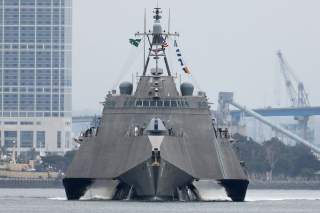How the Navy's Terrible Littoral Combat Ship Just Got a Little Better
It can now carry and shoot the Naval Strike Missile.
Key point: America's LCSs are really bad, but being able to hit another ship with a high-tech missile is a step in the right direction.
The U.S. Navy Littoral Combat Ship USS Gabrielle Giffords fired an anti-ship missile at a target vessel during an Oct. 1, 2019 exercise off the coast of Guam.
The missile-shot signals an important, if greatly delayed, expansion of the LCS’s weapons capability. The two-variant class for years has come under fire for being lightly-built and under-armed for major warfare.
Gabrielle Giffords, a triple-hull Independence-variant of the LCS, launched a Naval Strike Missile at the ex-USS Ford, a decommissioned frigate, as part of a joint sink exercise, or SINKEX, that also involved the Republic of Singapore Navy.
The Naval Strike Missile is a new addition to the LCS. The 13-feet-long, sea-skimming missile weighs 900 pounds and can strike targets as far as 100 miles away, making it by far the LCS’s most powerful weapon.
An LCS can be fitted with two quad launchers for the Norwegian-designed missile. Giffords is the first of the 3,000-ton-displacement ships to carry the weapon, although it could become standard on the class.
“That’s a game-changer for LCS,” Rear Adm. Casey Moton, the program executive officer for unmanned and small combatants, told USNI News. “They still have their mission, they still have their focused mission and all the things that they’re going to do in the surface warfare world and in [anti-submarine warfare] and [mine countermeasures.”
But with Naval Strike Missiles in their arsenals, LCSs now pose a threat to even larger enemy surface ships, as well. “Now, every LCS that’s out there can’t be ignored,” Moton said.
The addition of the new missile is a welcome development for the growing LCS force, which after years of developmental problems finally is beginning to send ships out on deployment.
The Navy has spent $30 billion over a period of around two decades in order to acquire just 35 LCSs. Sixteen were in service as of late 2018. Of those 16, four are test ships. Six are training ships. In 2019 just six LCSs in theory are deployable.
While that number should increase as the remaining ships in the class finally commission into service, the LCS’s low readiness rate has called into question the wisdom of the Navy’s investment in the type.
Indeed, the Navy in 2018 didn’t deploy a single LCS, USNI News reported. Fleet officials in early 2019 claimed at least three LCSs would deploy before the end of the current fiscal year in September 2019.
“We’re deploying LCS this year, it’s happening,” Commander of Naval Surface Forces Vice Adm. Richard Brown told reporters. “Two ships are going on the West Coast; one ship is going on the East Coast, followed shortly [by a second] in the beginning of ‘20. And that marks the deployment of LCS; there will always be LCS forward-deployed now, just like we designed the program.”
Brown said Giffords and the LCS USS Montgomery would deploy from San Diego to the Western Pacific while USS Detroit deployed from Florida. USS Little Rock in early 2020 also would deploy from Florida.
U.S. Southern Command in February 2019 announced that Detroit would conduct counterdrug operations. "We expect to have a littoral combat ship this year, and that will be a big benefit for our exercise program for our engagement with partners and because of the flexibility it brings for counter-narcotics interdiction," SOUTHCOM commander Adm. Craig Faller said.
When the Navy in the 1990s first began shaping the LCS program, the idea was for the ships to be small, fast, inexpensive and lightly-manned “trucks” into which the sailing branch could plug a wide array of “modules” carrying equipment for specific missions including surface warfare, anti-submarine warfare and minesweeping.
In a bid to speed up production of as many as 55 LCSs, the Navy selected two shipyards -- Lockheed Martin’s facility in Wisconsin and an Austal yard in Alabama -- each to build their own variant of the class. Complications and cost compounded.
The sailing branch in 2014 cut LCS acquisition from 55 ships to 32. Congress eventually added three vessels, boosting the class to 35 ships. In place of the 20 canceled LCSs, the Navy plans to buy 20 new missile frigates. The service in 2019 asked Congress for around $1 billion for the first ship in the new class.
In contrast to the LCS in its original guise, the new frigate will be a conventional vessel with a large crew and hard-wired systems. And it will pack powerful anti-ship missiles from the very start.
David Axe serves as Defense Editor of the National Interest. He is the author of the graphic novels War Fix, War Is Boring and Machete Squad. This first appeared in October 2019.
Image: Reuters.

